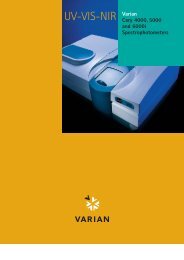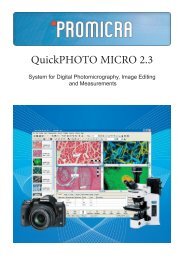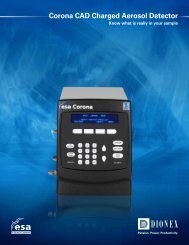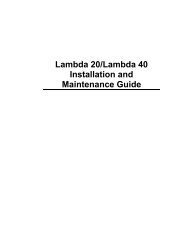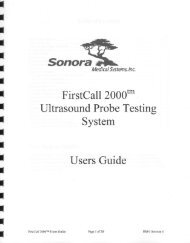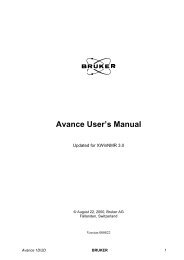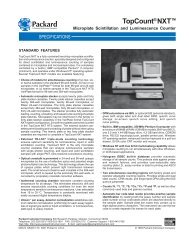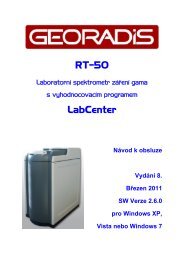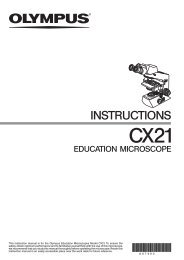where R is the electrical resistance of the junction and thermocouple lead wires in the immediate vicinity of thejunction. The second, or heating, term of the equation is negligible at small values of I, but because the heatingeffect increases with the square of I, it rapidly becomes the dominant factor in the equation. Thus, in thermocouplepsychrometers, there is an optimum value of cooling current that will produce maximum temperature depression,beyond which a further increase in current will actually reduce the cooling effect. Furthermore, microscopicdifferences in the geometry and alloy makeup of the junctions influence the value of R and hence the net coolingeffect. Thus, while the thermocouple voltage - temperature sensitivity, P ab , and the Peltier Coefficient, A ab , willbe identical in every junction made from the same two materials, the maximum cooling capability of a junctionwill vary somewhat from one junction to the next.When the temperature of the junction is depressed by means of Peltier cooling, heat will begin to flow into it fromits surroundings. This transfer of energy will limit the maximum realizable temperature depression, dependingupon numerous factors including chamber geometry, volume, and materials. When these factors are fixed,however, the maximum realizable temperature depression of the junction is also fixed. This maximumtemperature depression is of concern in thermocouple psychrometry, and of particular interest where the dew pointmethod is used.From the foregoing, it is clear that the Peltier Coefficient, A ab , does not, by itself, determine the maximumtemperature depression of the junction. For our purposes, therefore, we shall define a slightly different coefficientwhich we shall call the cooling coefficient. It shall be a characteristic parameter of a given thermocouplepsychrometer, representing its maximum junction temperature depression resulting from the passage of anominally optimum cooling current. Since the temperature of the junction is directly related to its thermoelectrice.m.f., the cooling coefficient will be expressed in microvolts (this is in harmony with the Peltier Coefficientwhich, as defined above, also has units of Watts-Ampere, or Volts).DEFINITION: The cooling coefficient A v , for a given thermocouple psychrometer is defined as thedifferential e.m.f. in microvolts that results from the passage of a specified nominally optimum coolingcurrent through the junction at a specified ambient temperature.Stated mathematically: A v = P ab )T m (5)where )T m is the temperature differential that results from the given current. The measurement of A v must beperformed in such a way that the differential e.m.f. is measured immediately after cessation of cooling currentflow, and is completely independent of any consequential effects of the current other than the temperaturedepression of the junction. These requirements are fulfilled in the <strong>HR</strong>-<strong>33T</strong>.Statistical data on a large number of Wescor Thermocouple Psychrometers have shown that the optimum coolingcurrent is typically 8.0 milliamperes. This value of cooling current is standard in the <strong>HR</strong>-<strong>33T</strong> <strong>Dew</strong> <strong>Point</strong><strong>Microvoltmeter</strong> (RMS current = 8 mA at 95% duty cycle).18
4.2 – Psychrometric MethodThermocouple psychrometers provide a measurement of water potential in situ or in sample chambers throughtheir ability to sense the relative humidity of their environment, this parameter being linearly related to waterpotential within the range from 0 to approximately &70 bars. With the psychrometric method, the junction iscooled by the passage of an electrical current through it (Peltier Effect) to a temperature below the dew pont, thuscausing pure water to condense upon the junction. Having accomplished this, the cooling current is discontinued,and the condensed water allowed to evaporate from the junction back into the surrounding atmosphere. Theevaporating water draws heat from the junction (heat of vaporization), depressing the temperature of the junctionfrom that of the surrounding air temperature. The magnitude of the temperature depression depends upon therelative humidity and the temperature of the surrounding air; the drier (and warmer) the air, the faster theevaporation rate and the greater the depression. The temperature of the junction is measured by electrical meansprior to cooling and during evaporation. The differential temperature of the junction is an explicit function of therelative humidity and hence of the water potential in the media being measured. 4 Thermocouple psychrometershave a typical responsivity near 0.47 µvolts bar -1 at 25°C. Because the effects of temperature must be removedfrom the measurement, a correction for ambient temperature, if other than 25°C, is made to obtain the true waterpotential (refer to Paragraph 2.2).4.3 – <strong>Dew</strong> <strong>Point</strong> MethodIn the psychrometric method, the temperature that the junction attains while water evaporates from its surface isalways lower than the ambient, but higher than the dew point temperature. This fact becomes obvious when onerecognizes that if the junction were somehow to be held at the dew point temperature, no water would evaporatefrom it. This simple observation is the fundamental principle upon which the dew point thermocouple methodis based, to wit:If held at the dew point temperature, a wet thermocouple junction will neither lose water through evaporation norgain water through condensation.4Rigorous analyses of the principles of thermocouple psychrometry are available in the literature.A simplified and generalized description of the process is used here to provide a basis for comparison withthe dew point method.19



